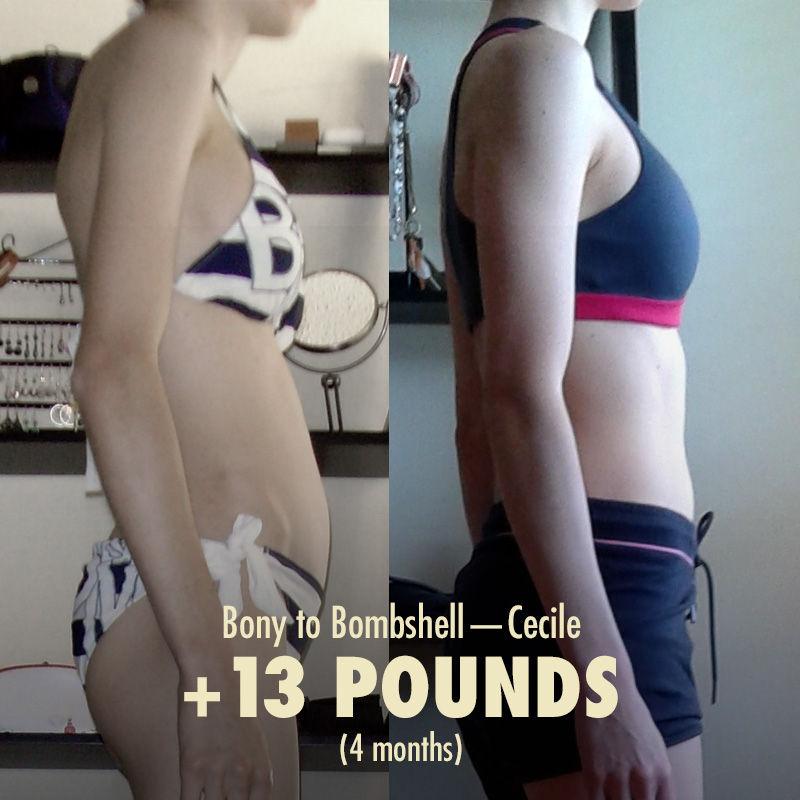
How To Gain Weight For Skinny Females
In this guide, we’re going to talk about a muscle-building diet plan designed for naturally skinny women who are trying to gain weight. Make no mistake, this isn’t a weight-loss diet plan. It’s not even a diet for the average woman who wants to become leaner and stronger. This is a bulking diet for women, a diet that will help you gain weight. Lean weight from muscle, yes, but the scale will still move up.
Muscle-building nutrition can be overwhelming at first, especially for beginners. How much should you eat? Which foods are healthy? Should you avoid carbs or sugar? Why are ketogenic and vegetarian both so popular despite being seemingly contradictory? Will intermittent fasting help you gain weight more leanly?
But nutrition can also be pretty simple if you focus on the fundamentals. There are just two factors that make the difference between gaining nothing or gaining 0.25–1 pounds of muscle every week so that you’re 1-4 pounds heavier each month. But there are hundreds of things that make the oh-so-small difference between gaining 0.25 and 0.26 pounds of muscle. So let’s focus on the big stuff first, master it, and then worry about the small fries later.
This article is for beginners. It’s for skinny women who haven’t quite figured out how to gain weight yet. And it will help you gain weight consistently on the scale every single week. Keep in mind that gaining weight through muscle becomes harder and harder as you become more and more advanced, so we recommend learning the advanced stuff eventually. But there’s plenty of time for that later, once you’re already building muscle.
Right now, though, you just need to worry about the two most important factors: calories and protein. And, ideally, getting most of those calories from unprocessed whole foods.
How to Gain Weight: Calories
To gain weight you need to be in a calorie surplus. When you consume fewer calories than your body needs, your body is forced to burn stored energy (fat) and stored nutrients (muscle) to get the energy it needs. This causes weight loss. However, when you consume more calories than your body needs, your body has a surplus of energy, and that energy can be stored.
- Calorie surplus = weight gain
- Calorie balance = no change in weight
- Calorie deficit = weight loss
So “being in a caloric surplus” simply means “eating enough to gain weight.” This makes weight gain simple. Not easy, but simple: if you’re not gaining weight as quickly as you’d like, you need to increase your calorie intake.
We’re interested in gaining muscle, not just gaining weight through fat, so our goal is to store that extra energy as muscle mass. But before we can do that, we need to ensure that there’s extra energy available to be stored. Without that extra energy, you won’t be able to store anything at all.
When gaining weight under normal conditions, women generally gain around 60–70% of that weight as fat. So if you gain twenty pounds while eating a regular diet and doing regular exercise (e.g. cardio), then you’ll gain something like 7 pounds of muscle and 13 pounds of fat. That will help you become stronger and more muscular. After all, you’ll need to carry that extra fat around the block and up flights of stairs (which explains why overweight women have such strong lower bodies).
But we recommend building muscle leanly. You’ll gain more muscle and less fat, and it will have a better impact on your strength, athleticism, appearance, and health.
The good news is that if you’re brand new to lifting weights, you’ll benefit from so-called “newbie gains.” Beginners are often able to build muscle quite quickly and leanly. You may even be able to lose fat while doing it. Here’s how much muscle and strength women can expect to gain during their first year of lifting. For another example, here are Cassandra’s muscle-building before and after photos from gaining 22 pounds:

Now, to be clear, you won’t be able to lose fat while building muscle forever, and you may not even be able to do it now. Here are some examples of women’s weight-gain transformations after a few months of lifting weights. As you can see, some people gain more fat than others. However, regardless of your genetics and circumstances, the vast majority of your gains can probably be lean.
So how do we do this?
Before You Eat Big, You Need to Lift Big
Before eating more food, you need to prime your body for lean weight gain. You need to start lifting weights. You can do that by joining a commercial gym, setting up a barbell home gym in a spare room, or even just buying a pair of adjustable dumbbells that you can use in your living room. In a pinch, you could even start following a bodyweight workout routine that would require no equipment.
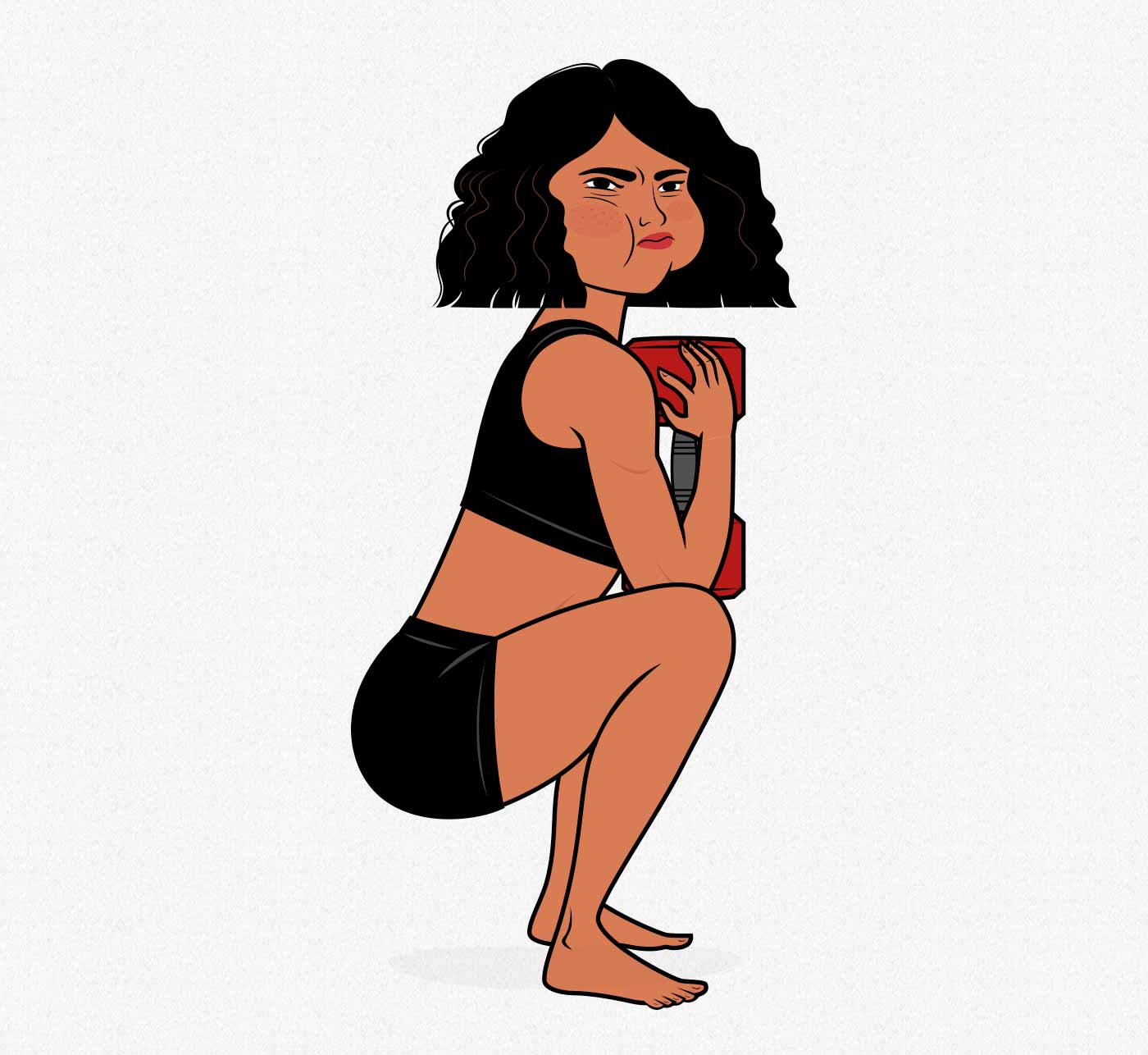
You don’t need any fancy equipment. Your plan doesn’t need to be complicated. But you do need a structured plan that will challenge your muscles. Bigger muscles are stronger muscles, so to get gradually bigger, you need to start getting progressively stronger.
For more, we have a beginner workout guide for women here. It’s simple, free, and perfectly effective.
How Quickly Should A Skinny Woman Gain Weight?
Once you’re lifting weights, the next thing to consider is how quickly you should be gaining weight. By adjusting how many extra calories you eat, you can control how quickly you gain weight.
The faster you gain weight, the faster you’ll gain muscle, but you’ll also be more likely to store more fat. The slower you gain weight, the harder it will be to build muscle, but the less fat you’ll gain. So the idea is to give your body enough extra nutrients to build muscle, but not so much that the extra, extra nutrients are stored as body fat.
The ideal rate of weight gain depends on your genetics, your experience level, and how good your workout program is.
- Your genetics and experience level are probably assets. If you’re a skinny girl that is a total beginner when it comes to working out, you’re still very far away from your genetic potential. Your genetics aren’t likely to limit you. You’ll do great.
- If you train specifically for muscle growth, you can be more aggressive with weight gain. Our Bony to Bombshell program is designed to stimulate muscle growth. So just make sure you follow a muscle-building workout routine that is designed for females, you give it your best effort, and you’re consistent.
So for the average naturally skinny woman who’s following a good muscle-building program, we recommend gaining weight pretty fast—about 0.25–0.75 pounds per week.
If you gain less weight than that, increase your calorie intake. If you gain more weight than that, reduce your calorie intake.
How to Eat Enough To Gain Weight
When we mention that you’ll need to eat more calories, most people think that they’ll need to track calories on an app to gain weight. But the good news is that you don’t have to do that if you don’t want to. We’ll teach you a few different methods. You can pick the method you prefer.
But even if you aren’t tracking calories, it still helps to know what’s going on under the hood. So let’s talk about the calorie requirements of gaining weight and building muscle.
It takes around 3,500 to gain a pound of fat, and a bit less than that to gain a pound of muscle. So to gain around 0.5 pounds per week, you should eat around 250 extra calories every day. But you’ll also be burning calories while working out, and your metabolism will speed up as you start eating more food, so you may need to eat even more than that. The trick is to weigh yourself every week, see how much you gain, and then adjust accordingly.
- If you’re gaining less than 0.25 pounds per week, eat 200 extra calories each day.
- If you’re gaining more than 0.5–0.75 pounds per week, eat 100 fewer calories each day.
The first week can be a bit of a toss-up. You’re adding in the workout routine but you’re also adding more food into your digestive system. Sometimes your weight will jump up or flatten out. Don’t read too much into it. And besides, lifting weights will be such a novel stimulus that you’ll probably lose a bit of fat and gain a bit of muscle even if you aren’t gaining weight.
Even after the first week, this can be a finicky process. You don’t need to be perfect at it. Even if you aren’t gaining the same amount of weight each week, as long as there’s an overall trend upwards, you’ll do great. (You should also notice that you’re getting stronger each week.)
Okay, now, let’s talk about how to determine your calorie needs. There are two ways to calculate how many calories you need:
- Eating intuitively: taking your diet as it is now, adding in extra food, and eating a bit more or less depending on how much weight you gain each week.
- Calorie tracking: starting from scratch, calculating your body’s calorie needs, and tracking the food you eat. You can then adjust your intake in 200-calorie increments each week, depending on whether you’re gaining weight or not.
Let’s go over the pros and cons of both methods.
Method One: Eating Intuitively To Gain Weight By Adding Calories
This method assumes you’re already eating enough calories to maintain your body weight. If that’s the case, that means you’re in energy balance. You aren’t in a calorie surplus or deficit. So all you need to do is eat a bit more.
To gain around half a pound per week, you need 200–300 extra calories per day. That’s a large glass of milk or soy milk (500ml), a small bowl of trail mix (1/3 of a cup), a Quest protein bar, or two scoops of protein powder. You don’t need to eat that much more, especially if you choose calorically dense foods like olive oil, avocado oil, trail mix, dried fruits, roasted nuts, smoothies, soy milk, and milk.
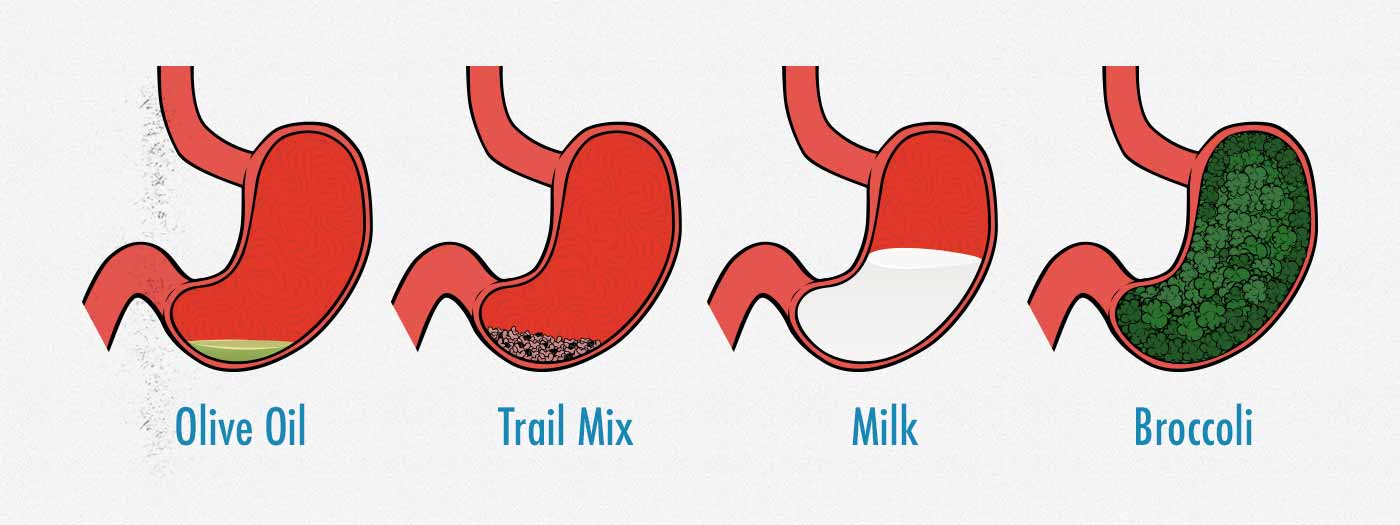
After a week of eating big, step on the scale, and see how much weight you gained (or didn’t gain). Then adjust your calorie intake as needed. If you didn’t gain weight, add in another 200 calories. If you gained too much weight, eat 100 calories less.
This option of eating intuitively is simple and effective, but it only works if you already have a very consistent diet. For example, if you wake up in the morning and have breakfast, bring a packed lunch to work, and then come home and eat dinner with your family. In this case, since you have a steady routine, it’s easy to add in an extra snack without changing anything else.
The whole method relies on the fact that you eat consistent meals and serving sizes, though. If you add in a snack between breakfast and lunch, but then you aren’t as hungry for dinner, so you eat less… that won’t work. You need to be able to keep your diet consistent, adding in extra calories.
Your body wants to stay the same, and it has dastardly tricks to keep you that way. Let’s say you make a sugary Starbucks run twice a week to satisfy some cravings. Or maybe you order takeout once a week. Those are extra calories that you get sometimes. Not often. They’re not part of your regular routine. But that’s your body’s way of keeping your weight steady each week. Thing is, now that you’re adding extra calories into your diet, those cravings might disappear. So now you’re eating a bit more calories every day, but you aren’t getting those biweekly calorie infusions anymore. And so you don’t gain weight.
Since your appetite will naturally cue you to eat enough to maintain your weight, these subconsciously caloric adjustments are very common. They’re very sneaky. Watch out for them.
Fortunately, this muscle-building diet is self-correcting. If you’re adding in another 200 calories every week, you fail to gain weight, then eventually, you’ll start consistently gaining weight. As long as your diet has some structure to it, this method will eventually start to work. And whenever it stops working, it will fix itself again.
If your diet is too sporadic, though, you might want to count your calories with an app instead.
Method Two: Tracking Calories To Gain Weight
This option is best if you want to build a weight gain diet plan from scratch. The goal here is still to develop a fairly consistent routine, though, so that you can eventually switch back to option #1. Counting calories every day isn’t a sustainable lifestyle for most people. It’s not something you want to do forever. It’s only something you want to do for now, as you’re learning how to gain weight.
Plus, your body has a rhythm to it. If you eat meals at the same time every day, your digestive system will prepare for them. You’ll get into the rhythm of digesting meals at certain times. It’s not the end of the world if you fall off your schedule, but eating enough food is already hard enough as is. We might as well make it as easy as possible.
So how many calories should you be eating? That’s a tricky question. Calorie algorithms can get pretty complicated. Different people have different body compositions, diets, lifestyles, and goals.
Fortunately for us, we can simplify it by focusing on a specific niche: skinny women who are working out and eating to build muscle as lean weight.
For the average thin woman eating a balanced diet with a moderate protein intake and working out every second day (for about 3 hours total each week), this calorie intake should get you very close to your maintenance calorie needs:
- Maintenance Calories = weight (pounds) x 13
- Maintenance Calories = weight (kilos) x 29
Then adjust a little based on your lifestyle:
- If you wake up, drive to work and sit at a desk all day, decrease the multiplier by 1, making it 12 (if you use pounds) or 29 (if you use kilos).
- For every extra hour of exercise you do per week—in addition to your muscle-building workouts—add an extra 1 to the multiplier. For example, if you play two volleyball games every week, each lasting about an hour, your multiplier would be 15 (if you use pounds) or 31 (if you use kilos).
This should roughly reflect what you’re already eating. It won’t be perfect, but it should be about right. If the number seems way off, feel free to adjust it up or down by another 10%. Metabolisms vary from person to person, and chances are that you already know whether yours is larger or smaller than average.
Now we need to add in the calorie surplus. Just like with option #1, this means adding 200–300 calories per day on top of your maintenance needs. From there, weigh yourself every week and adjust accordingly. If you don’t gain weight, eat 200 more calories per day. If you gain too much weight, eat 100 fewer calories per day.
Examples of Easy Ways To Add Calories To Your Weight Gain Diet
- Increase three meals by 100 calories each. Perhaps you do that by adding a small glass of milk to your meals. Liquid calories are fairly easy on the appetite, so this should be fairly achievable.
- Add in a couple 150 calorie snacks. Snacks have been shown to instinctively cause people to eat more, and they will allow you to keep your main meals reasonably sized. These snacks could be as simple as a homemade protein bar split in half, a whey isolate protein shake, a handful of trail mix, a couple pieces of dark chocolate, or a couple pieces of fruit.
- Add in a fourth (or fifth) meal. Maybe a small fruit/protein smoothie, or some muesli cereal with milk and frozen berries, a homemade protein bar, or a store-bought one—like a Quest protein bar. All of these options are quick to prepare and consume, rich in fibre, contain a fruit or vegetable (except for the Quest bar), and contain enough protein to spike muscle protein synthesis.
- Have (more) dessert. If you already eat a pretty healthy diet that’s rich in protein and made up mostly of whole foods, perhaps you could just have a 250-calorie dessert after dinner. Bonus points in terms of health if you make the dessert yourself.
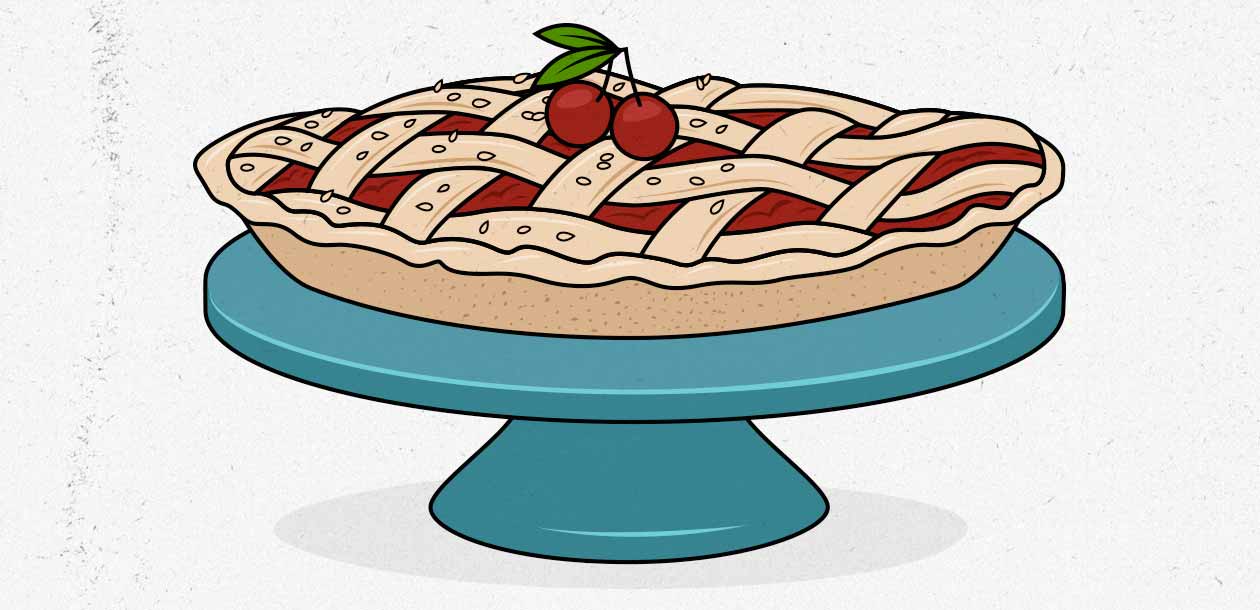
Best Foods To Gain Weight
You can gain weight with a wide variety of foods. You don’t need to eat a specific diet, you just need to eat enough good food. Even so, some foods make it much easier to bulk than others. They share a few common characteristics:
- They have a high energy density. Foods with a higher energy have more calories per unit of volume. They take up less room in your mouth, allowing you to devour calories faster. They also occupy less room in your stomach, allowing you to eat more food before you run out of room. For skinny-stomached people like me, that’s a huge boon.
- They’re good for building muscle. Foods higher in protein, starchy carbs (or unprocessed sugars), and healthy fats are fantastic for building bigger muscles. Protein is the building block of muscle tissue, starchy carbs are the fuel our muscles use, and healthy fats keep our hormones running smoothly, telling our bodies what to do with these nutrients. Then there are fibrous and fermented foods, which improve our digestion. And foods that improve our blood flow, enhancing our muscle growth.
- They’re good for our health. A good bulking diet is built out of nutritious foods. Think of whole or minimally processed foods, including lean meat, seafood, fruits, vegetables, legumes, seeds, nuts, dairy, herbs, spices, and much more.
Not every good weight gain food satisfies all three criteria. For example, carrots and spinach aren’t rich in calories or easy to digest, but they’re packed full of micronutrients, including nitrates, increasing our rate of muscle growth (study). You could make a similar argument for garlic, which improves blood flow.
On the other side of the spectrum, consider white rice. White rice is stripped of its fibre, making it less nutritious than other whole grains, such as brown rice, oats, quinoa, and corn. However, it still retains some micronutrients and has a few key weight gain advantages: it’s high in starchy carbs, easy to prepare, easy to eat, and quick to digest. As a result, it makes for a great side, especially if you’re having it along with some salmon and vegetables or perhaps under a bed of stir fry, picadillo, or vindaloo.
- Fermented dairy is rich in protein, calcium, and probiotics. Probiotics are great for our digestion, which is key when bulking. Think of cheese, cottage cheese, Greek yogurt, and kefir.
- Other fermented foods are rich in probiotics, too. Think of sauerkraut, miso, natto, tempeh, kombucha, and kimchi.
- Whole grains and legumes are nutritious starchy carbs. They’ll pump your muscles full of glycogen, improving your workout performance and supporting muscle growth. They’re also rich in soluble fibre, which regulates blood sugar, blood lipids, and digestion. Think of corn, quinoa, oats, beans, lentils, soybeans, peanuts, and brown rice.
- Fruits and berries are rich in vitamins, minerals, fibre, phytonutrients, and antioxidants. They’re also a nutritious source of unprocessed sugar, giving us the energy to lift and grow. Think of bananas, mangoes, papayas, apples, pears, oranges, limes, and mixed berries.
- Fibrous vegetables are pitifully low in calories but make up for it by being rich in fibre, along with wide range of micronutrients. Many are rich in nitrates, improving blood flow, giving you bigger muscle pumps, and increasing muscle growth. Think of carrots, spinach, broccoli, cauliflower, asparagus, beets, and peas.
- Nuts and seeds are rich in healthy fats, protein, and fibre and packed full of micronutrients. Think of walnuts, almonds, Brazil nuts, cashews, pistachios, pumpkin seeds, chia seeds, flax seeds, and hemp seeds.
- Herbs, spices, and garnish add flavour and nutrients to your meals. Many of them have interesting health benefits. Think of garlic, onions, diced tomatoes, pepper, turmeric, oregano, cilantro, mint, hot peppers, and soy sauce.
- Sauces and dips are another way to add joy to your meals. Many of them are quite nutritious. Think of honey, mustard, nut butter, soy sauce, hot sauce, tahini, homemade mayonnaise, olive oil, vinegar, hummus, salsa, Tzatziki, and guacamole.
- Oils have the highest energy density of any food. Extra virgin olive oil is great for drizzling on salads and veggies. Avocado oil is great for cooking with.
- Coffee and tea are natural sources of caffeine and rich sources of phytonutrients. They’re quite healthy, provided you keep them away from bedtime.
Important: Adjust Your Calorie Intake Each Week
The most important thing about your bulking diet is to adjust it based on whether you’re gaining weight or not. We’ve been saying this a lot, but it’s really important. If you aren’t gaining weight, you need to add a bit more food to your diet. It’s a hard truth. When you’re already eating a lot, the last thing you want to hear is that you need to eat even more. But that’s the truth of it. That’s what you have to do.
You’ll need to track your results and adjust as you go to guarantee that you’re consistently gaining weight. This will also correct for calorie tracking errors or incorrect calorie estimates. It makes the system self-correcting. This is what will allow you to gain weight consistently, week after week, even if your body is naturally resistant to weight gain. Our bodies are resistant to weight gain, too. We know what it’s like. It’s hard, but it works.
Also, remember that this isn’t forever. Gaining weight is difficult. But once you reach your goal weight, you switch back to maintenance. You can follow your appetite again. Maintaining your results is easy, enjoyable, and feels natural. Your body will reach a new normal point of homeostasis.
Weigh yourself each week and see how much your weight has changed. You should buy your own digital scale to keep in the bathroom. We recommend waking up on Sunday morning, peeing, and then stepping on the scale. This will keep your stomach contents and hydration as consistent as possible from weigh-in to weigh-in. Then, if you aren’t seeing the weight-gain results that you want, simply add 200 calories to your daily target. Or, if you’re gaining weight too fast, remove 100 calories.
If you’re a skinny beginner, we recommend gaining around 0.25–0.75 pounds per week. Every week, depending on how your weigh-in goes, you can adjust your calories up or down to get closer to that pace. 0.25 pounds per week is good if you’re more afraid of gaining fat. 0.75 pounds per week is good if you’re more eager to gain muscle. If you want to take a middling approach, aim for 0.5 pounds.
This is how to guarantee progress. If something isn’t working, you just keep adjusting things until it does. When it comes to gaining weight, your calorie intake is the variable you need to adjust.
If you’ve been working out for a few weeks, you haven’t gained any weight, and you’re thinking, “Damn, am I doing the wrong workouts? Are my genetics bad? Am I eating a poor diet?” But no, it’s none of that. You’re looking for the problem in the wrong place. The recipe is fine, you just need more ingredients—more calories.
Speaking of which, it’s common for naturally skinny women to have trouble eating enough calories to gain weight. Here’s our guide for eating more calories.
How Much Protein Do You Need?
Why Is Protein Important for Weight Gain?
Weight training will get your body trying to build muscle, getting into a calorie surplus will give you enough energy to gain weight, and consuming enough protein will give your body the building blocks that your body needs to construct new muscle tissue. (Muscle is made out of protein.) This is the trifecta of lean weight gain through muscle growth: lift weights, eat enough calories, and eat enough protein.
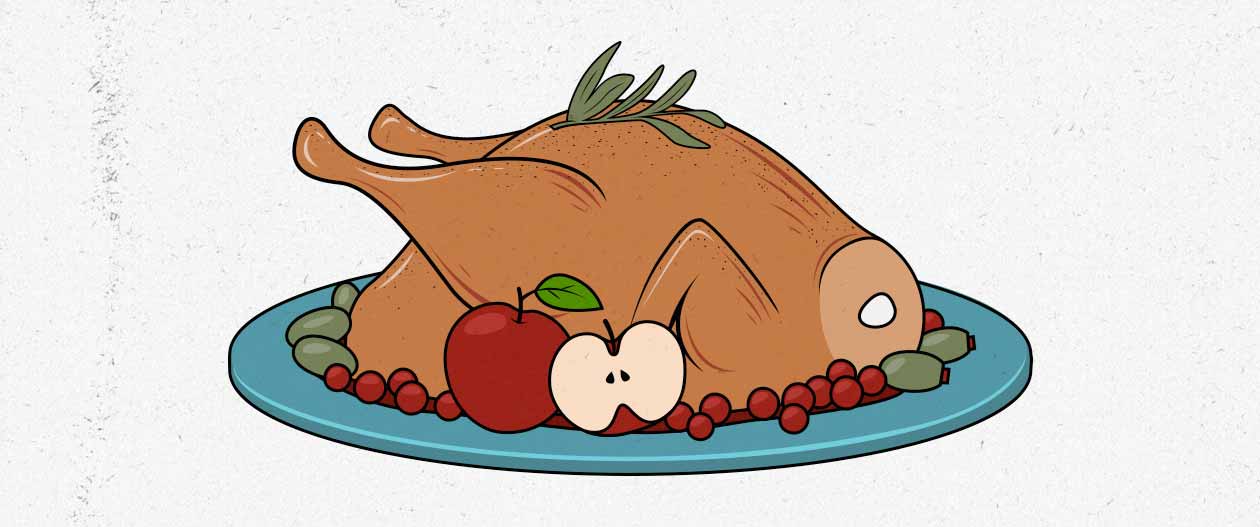
How Much Protein Should You Eat Per Day?
Most research shows that around a gram of protein per pound bodyweight per day (2.2 grams per kilo) is ideal for building muscle. That’s probably more than you eat right now, but it’s nothing crazy. If you have trouble hitting that goal, remember that you can always buy some protein powder.
Keep in mind that this is how much protein it takes to build muscle. You don’t need to eat this much protein forever. Muscle doesn’t take as much protein to maintain. This is why you’ll sometimes see very muscular people eating far less protein than this. Once you reach your goals, you can eat a bit less protein without fear of losing muscle.
What Are the Best Foods To Gain Muscle For Females?
There are lots of great protein sources:
- Chicken
- Fish
- Lean meat
- Dairy—particularly raw or fermented—such as kefir, Greek yogurt, cottage cheese
- Eggs, nuts, whole grains, seeds, and legumes. They aren’t pure protein sources, but it adds up.
- Soy isolate protein powder, whey isolate protein powder, and other plant-based protein powders
- Smoothies that include a protein powder
This makes eating enough protein pretty easy if your diet has no restrictions. If your diet does have restrictions, buying a suitable protein powder tends to solve the problem.
Whey protein is cheaper than chicken and fantastic for building muscle. There are many great types of protein powders. For example, pea + rice protein powder is great for people who have problems with processed dairy or prefer avoiding animal products.
Mixing some protein powders alongside other healthy foods as a smoothie is an incredible way of getting enough protein, enough nutrients, and consuming those calories in a way that’s easy on the appetite.
GET THE sample PDF recipes OF THE
weight-Gain Muscle-building Smoothies
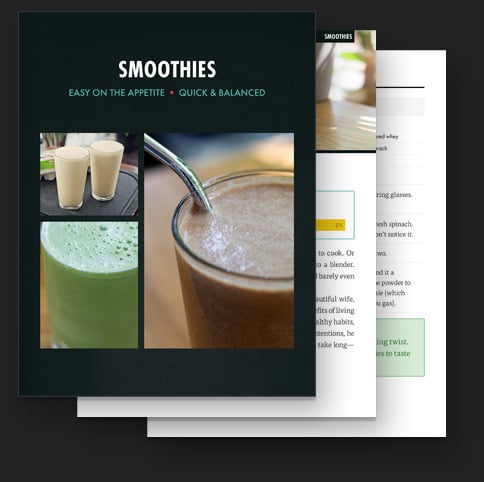
Get some sample smoothies recipes in a downloadable PDF file. Get the full explanation, ingredient list, macros, and steps to follow.
Plus, we’ll make sure you’re on the Bony to Bombshell newsletter, and send you all of our best women's muscle-building content.
If you’re a vegan or vegetarian, here’s our guide for building muscle on a vegan diet, and here are some good plant-based protein sources.
Is It Healthy to Eat More Protein?
Yes, most research shows that diets higher in protein are totally healthy. Not only is protein rich in nutrients, but it also supports a lean, strong, and athletic physique. Make sure you’re still eating plenty of other good foods, too, though. Lots of fruits, veggies, legumes, and so on.
How Much Protein Should Women Have Per Meal?
Hitting your overall daily protein goal is the most important thing, but splitting up your protein evenly over the course of the day can help, too. In an ideal world, you’d have at least three meals per day and at least 20 grams of protein in every meal. (Intermittent fasting is okay for losing fat, but it doesn’t seem ideal for building muscle, especially for naturally skinny people.)
For example, if you weigh 130 pounds, your diet might look like this:
- 30 grams of protein with breakfast.
- 30 grams of protein with lunch.
- 40 grams of protein with dinner.
- And a protein shake as a snack—27 grams of protein.
That gives you 130 grams of protein, and that protein is spread somewhat evenly over the course of the day, with at least 20 grams of protein in each meal. That’s a classic way of structuring a muscle-building weight-gain diet, too.
Keep in mind that you might not be used to eating protein in every meal. For example, Cassandra (from the first before and after photo) wasn’t used to eating much protein with breakfast. To fix that, she switched from using almond milk to soy milk in her morning latte, and she added a scoop of collagen powder to it. That gave her an extra 8 grams of protein from the soy milk and 10 grams from the collagen. (Collagen isn’t a complete source of protein for building muscle, but when combined with other protein sources in the diet, that doesn’t matter. She likes collagen because there’s modest evidence showing it might improve skin health.)
Keep Your Diet as Abundant As Possible
When trying to eat more calories, don’t make things harder than they need to be. If you don’t have any dietary restrictions, great. You don’t need any. You can build muscle with a wide and varied diet that’s pleasurable to eat. Don’t restrict carbs (or follow a ketogenic diet) unless you absolutely need to. You also don’t need to limit your sugar intake (as long as your diet isn’t overly high in it). You eat organic foods if you want, but you don’t have to.
Your muscle-building weight diet can be very flexible. Make it fun.
Most of these restrictive diets are designed for overweight people who need to restrict their calories to get down to a healthy weight. As someone who’s trying to gain weight, you can do the opposite: keep your diet flexible and indulgent and fun.
That said, you may find it easier to eat a somewhat repetitive diet at first, especially if you’re counting calories. That way, you won’t always need to calculate your calories from scratch. If you eat the same snack before bed every night (such as cottage cheese with a spoonful of strawberry jam), you don’t need to calculate the calories. You already know how many calories are in it and how much protein it has.
And you may want to make some food swaps to make bulking easier. For instance, if you normally wake up and have a coffee and a muffin at Starbucks for breakfast, consider switching that to having a milk or soymilk latte, a muffin, and some yogurt with fruit at Starbucks for breakfast. Your routine is the same, and the switch won’t require much willpower. But the milk in the latte adds protein and calories, and the yogurt and fruit add calories, fibre, phytonutrients, and vitamins.
Summary
If you’re a naturally skinny woman who’s trying to gain weight through muscle, it all comes down to following a structured workout routine that’s designed to stimulate muscle growth, eating enough protein to build muscle, and eating enough calories to gain weight.
Here’s how to do it:
- Start working out first, then start eating more calories. Without the lifting, around 67% of the weight you gain will be fat. Once you start working out, though, you should be able to gain weight quite leanly.
- If you’re a skinny beginner, gaining 0.25–0.75 pounds per week is a good place to start.
- If your diet is made up mostly of whole foods, is fairly consistent, and your weight stays about the same each week, then you don’t need to count calories with an app. Add 200–300 calories to what you’re already eating. That will bring you into a small calorie surplus.
- If your diet needs a total overhaul, or you haven’t been able to gain weight by eating intuitively, you will want to track calories. 13x your bodyweight in pounds (or 29x your bodyweight in kilos) is about how many calories it takes to maintain your weight. So to start gaining weight, add another 200–300 calories on top of that. For a woman who weighs 100 pounds, that’s around 1300 calories to maintain and 1550 to gain.
- Weigh yourself each week and adjust your calorie intake accordingly. If you aren’t gaining weight, add another 200 calories. If you gain too much weight, remove 100 calories.
- Your weekly calorie surplus determines how much weight you gain each week. Ideally, you’d get into that weekly surplus by eating a small surplus every single day. But if you need to, you can make up for a day of undereating with overeating. So if you’re 200 calories short one day, eat an extra 200 calories the next day.
- Eat 0.8–1 gram of protein per pound bodyweight per day (2.2 grams per kilo). Most people can do this by eating protein-rich foods, such as meat, dairy, soy, legumes, and nuts. But if you find it hard to eat enough protein, consider buying some protein powder. It’s the easiest way to boost your protein intake.
- Eat the foods you already love—just add more calories and protein. You don’t need any dietary restrictions. Try to build a diet that you enjoy. The only thing we recommend is eating mostly whole foods. More fruits, veggies, legumes, yogurt, and nuts. Fewer packaged cookies and chips.
- Don’t fret about advanced nutrition techniques until this is easy! This is everything you need to build muscle and gain weight leanly and effectively.
If you liked this article, you’d love our muscle-building newsletter. We’ll keep you up to date on all the latest muscle-building information for women. Or, if you want us to walk you through the process of building muscle, including teaching you the lifts, giving you a full workout program, a complete diet guide, a recipe book, and online coaching, check out our Bony to Bombshell Program.
Good luck!

